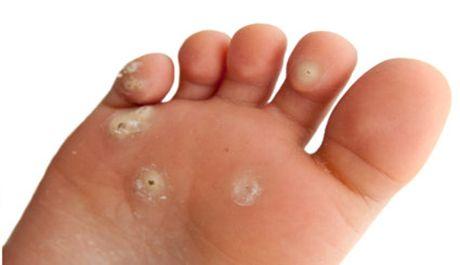
Warts are small, rough, non-cancerous lumps on the skin caused by a virus (human papillomavirus). Warts can occur anywhere on the body but occur most commonly on hands and feet. A wart that develops on the soles of the feet is called a verruca or plantar wart. Warts tend to affect children and teenagers more than adults.
Causes
Warts are caused by infection with a virus known as the human papilloma virus (HPV). The virus causes an excess amount of keratin, a hard protein, to develop in the top skin layer (epidermis). The extra keratin produces the rough, hard texture of a wart. Warts are contagious but the risk of passing them on is low. HPV can be passed on through close skin-to-skin contact. It can also be transmitted indirectly by contact with contaminated objects, such as towels, shoes, areas surrounding swimming pools, or the floors of communal changing areas.
Treatment
Most warts will clear up without treatment, with 65-80% gone within 2 years. Warts in adults and in people with a weakened immune system are less likely to clear up on their own.
Salicylic Acid
Salicylic acid is available over-the-counter in your totalhealth pharmacy as creams, gels and paints for topical treatment of warts and verrucas e.g. Duofilm, Salactol, Salatac. These are usually applied daily and can take 12 weeks or longer to treat the wart. Before applying the treatment, use an emery board to rub any excess outer skin on the affected area (avoid sharing these with others). Then soak the wart in water for around five minutes to soften the skin. Products containing salicylic acid should not be used on the face.
Cryotherapy
Your GP can carry often carry out this treatment. Liquid nitrogen is applied onto the wart to freeze and destroy the cells. A sore blister develops, followed by a scab which falls off seven to ten days later. Large warts may need to be frozen a number of times a few weeks apart. Treatment can be painful and cause blistering. This type of treatment is often suitable for warts on the face.
A very cold spray containing dimethyl-ether/propane e.g. Wartner is also available from your totalhealth pharmacy, which you can apply yourself.
Duct Tape
Treatment with duct tape involves placing a piece of duct tape over your wart for about six days. If the tape falls off you simply replace it with a fresh piece. After six days the tape is removed and the wart is soaked in water. After soaking the area in water, use an emery board to rub away any rough areas. The wart should be left uncovered overnight and a new piece of duct tape applied the following morning. This procedure is then repeated for a period of up to two months.There is limited evidence to support the effectiveness of using duct tape to treat warts, however, side effects are rare.
totalhealth pharmacist's advice
To help prevent a wart or a verruca developing, you should:
 not touch other people’s warts.
not touch other people’s warts.
 not share towels, flannels or other personal items with someone who has a wart.
not share towels, flannels or other personal items with someone who has a wart.
 not share shoes or socks with someone who has a verruca.
not share shoes or socks with someone who has a verruca.
 avoid scratching or picking your wart or verruca because it will encourage the HPV to spread to other parts of your body.
avoid scratching or picking your wart or verruca because it will encourage the HPV to spread to other parts of your body.
 take care when shaving because the virus can be spread easily if you cut yourself.
take care when shaving because the virus can be spread easily if you cut yourself.
 keep your feet dry, and change your socks every day.
keep your feet dry, and change your socks every day.
If you have a wart or verruca, you should cover it up when taking part in communal activities. For example, you should:
 wear pool slippers or flip flops in communal changing rooms and showers.
wear pool slippers or flip flops in communal changing rooms and showers.
 cover your wart or verruca with a waterproof plaster or a verruca sock when you go swimming, or while doing physical education at school.
cover your wart or verruca with a waterproof plaster or a verruca sock when you go swimming, or while doing physical education at school.
 wear gloves when using shared gym equipment if you have a wart on your hand.
wear gloves when using shared gym equipment if you have a wart on your hand.